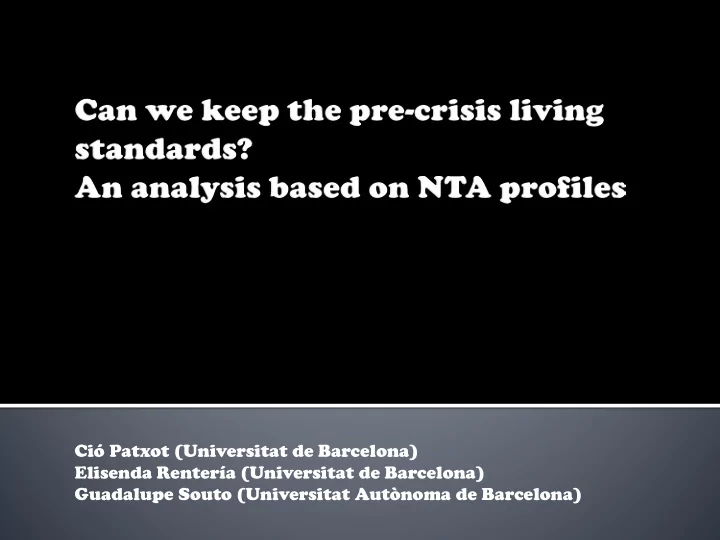

Ció Patxot (Universitat de Barcelona) Elisenda Rentería (Universitat de Barcelona) Guadalupe Souto (Universitat Autònoma de Barcelona)
Questions Deep economic crisis Spain is facing has raised questions about our economic situation and our perspectives for the future: Have Spaniards were living beyond our means? Can we keep our pre-crisis living standards or do we need to change our way of life to make it economically sustainable?
Macroeconomic outlook GDP decreased 1,3% in 2012 Unemployment above 25% High public deficits since 2008, and public debt increasing sharply
140% Corporate 120% Total debt in 1995: 140%, and 270% in 100% Households 2010. 80% 60% Public Private debt in 2010 is 40% three times the 1995 level !!!!!!!!!! 20% 0% 1995 1996 1997 1998 1999 2000 2001 2002 2003 2004 2005 2006 2007 2008 2009 2010 2011 2012
NTA converts the whole set of a given year NA in age specific flows, giving a cross-sectional picture of intergenerational transfers occurring in an economy in a given year. NTA give us very rich information about the consumption and production patterns in society. As these patterns are obtained by age, country demographic characteristics, not only economic ones, can be taken into account.
YL + YA + TG + + TF + = C + S + TG - + TF - Income sources = Income uses C -YL = (YA – S) + (TG + - TG - ) + (TF + + TF - ) LCD = ABR + TG + TF
Previous equations hold both for the whole economy and for any age group in particular. LCD can be positive or negative for each age group in particular. When negative, it needs to be financed through ABR , TG and TF. o ABR: mainly intertemporal redistribution o TG and TF: mainly intergenerational distribution Living standards of the whole society depend critically on the success of working-age population to generate enough resources to meet their own needs and non- working ages’ LCD (through TG and TF )
20000 2008 15000 10000 2000 5000 € (2000) 0 0 5 10 15 20 25 30 35 40 45 50 55 60 65 70 75 80 85 90 -5000 -10000 -15000
12,0% 10,0% 8,0% % of GDP 6,0% 4,0% 2,0% 0,0% 2000 2001 2002 2003 2004 2005 2006 2007 2008
80% 70% 60% 50% % of GDP C 40% LY LCD 30% 20% 10% 0% 2000 2001 2002 2003 2004 2005 2006 2007 2008
100% 10% 20% 30% 40% 50% 60% 70% 80% 90% 0% 1908 1920 1932 1944 1956 1968 1980 1992 2004 2016 2028 2040 2052 2064 2076 2088 2100 Young DR 2112 Total DR 2124 Old DR 2136 2148
Total LCD has grown between 2000-2008 despite the very favourable population age estructure From 2013 we will have no chances to control LCD with demographic factors. In fact, demographic transition will represent a hard cost that only can be compensated adjusting per capita profiles
25000 Labour income 20000 15000 2000 €per capita Consumption 10000 5000 0 0 5 10 15 20 25 30 35 40 45 50 55 60 65 70 75 80 85 90
18000 16000 Labour Income 14000 12000 10000 8000 6000 Consumption 4000 2000 0 0 5 10 15 20 25 30 35 40 45 50 55 60 65 70 75 80 85 90+
12000 10000 Private Consumption 8000 €(2000) 6000 Public Consumption 4000 Public Public Health 2000 Education 0 0 5 10 15 20 25 30 35 40 45 50 55 60 65 70 75 80 85 90 95100+
6000 5000 4000 3000 2000 1000 0 0 5 10 15 20 25 30 35 40 45 50 55 60 65 70 75 80 85 90 95100+ public Educ private Educ public Health private Health
6000 5000 housing M 4000 housing F food and clothes M € (current) food and clothes F 3000 leisure M leisure F transport M 2000 transport F other M 1000 other F 0 0 5 10 15 20 25 30 35 40 45 50 55 60 65 70 75 80
3000 2500 2000 1500 1000 500 0 0 5 10 15 20 25 30 35 40 45 50 55 60 65 70 75 80 Food Male Food Female Hotel and foodservice Male Hotel and foodservice Female
160% ABR 140% TF 120% TG 47,6% 100% 21,9% 80% 8,6% 60% 90,2% 40% 69,6% 20% 0% -20% -37,8% -40% MEN (65+) WOMEN (65+) -60%
Aggregated LCD in Spain has grown during the period 2000- 2008 despite the very favourable age population structure (the most favourable in two centuries) Looking at per capita profiles, from 2000 to 2008 an increase in the LCD of the children and the elderly is observed, not compensated by a bigger surplus of active ages Private consumption profile tends to decrease with age; but public consumption profile is clearly higher for older people (mainly because of health care profile).
Demographic projections for Spain show that the most favourable period in terms of dependency rates is just finishing (between 1983-2013). If per capita profile of LCD observed in 2008 keeps constant, the deep aging process in the next decades will lead to an unsustainable situation: working ages will not be able to generate enough resources to keep our way of life Aleix Saló, Españistán The current crisis as an opportunity to wake up and face the future….
Recommend
More recommend